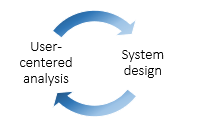User-centred design
User-centred focuses on designing products, tasks, and systems that take advantage of humans’ cognitive and physical capabilities, and account for their limitations. Our approach to user-centred design is reflected in this definition from the Handbook of Human Factors and Ergonomics (Salvendy, 2012, p1355): User-centred design is “based upon an explicit understanding of users, tasks, and environments…
- The design is driven and refined by user-centered evaluations;
- The process is iterative;
- The design addresses the whole user experience; and
- The design team includes multidisciplinary skills and perspectives.”
The following sections explore each of these principles further.
Understanding users, tasks, and environments
We analyse the characteristics of the system users, the tasks they will be performing with the system, and the environments within which they will be performing these tasks. A thorough understanding of these elements will provide valuable insights into the way users are likely to interact with the system, and help designers to optimise the design for safe and effective use.
User-centered evaluations
User-centered evaluations are an essential element of testing and analysis that informs design. Examples of user-centred evaluations are as follows:
- Descriptive studies: This describes how users are integrated within the system and how the parts of the system may influence each other.
- Experimental Research: This is conducted with a specific question and/or prediction in mind. A scenario is designed to determine the answer to the question and/or test whether or not the prediction is true.
- Evaluative Research: Evaluates the entire system to determine how effectively it serves its purpose. May use a combination of descriptive and experimental studies.
Measures can be focused on performance, physiological responses and/or subjective measures, for example:
- Performance measures: Measure quantifiable performance, for example, time taken to complete a task, or number of objects identified in a certain time.
- Physiological measures: Include skin conductivity, heart rate, and blink rate.
- Subjective responses: Include questionnaires and diary studies.
See ‘usability analysis’ for further information.
Iterative design process
User-centered design is an iterative design approach, where a product or system is created, then tested. Then, testing outcomes inform design changes, which go on for further testing.
Addressing the whole user experience
User-centered design is a wholistic process, which does not just focus on how the user interacts with a product or interface, but on the interaction of the product with the person’s goals, tasks, other systems or products, and work environment as a whole.
Multidisciplinary skills and perspectives
The user-centered design process utilises a multidisciplinary team. This approach may draw upon input from a range of professionals from various fields including psychology, engineering, IT, health and physical sciences, and/or industrial design.
Reference:
Salvendy, G. (Ed.) (2012). Handbook of Human Factors and Ergonomics (4th Edition). New Jersey: John Wiley and Sons.

